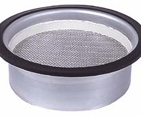Passive air cleaning methods, such as media filtration, electrostatic precipitation and adsorbent materials are used in HEPA air filters . These methods may be combined with ultraviolet (UV) light or active air cleaning methods, such as negative ion generators or ozone generators , in order to increase the performance of HEPA air purifiers.
Air cleaning methods
 The simplest technique is media filtration, which involves a filter most often made from an advance technology paper, textile, metal, synthetic, glass, or other material. The media filtration in a HEPA filter is made of submicronic glass fibers, that is as thick as blotter paper. As air is blown through the filter, usually with a blower attached to a motor, indoor allergens such as smoke, pollen, dust, mold spores, and bacteria, become trapped in the filter while the air flows freely through the filter. Harmful particles are eliminated from the air and the air that returns to the room is clean and fresh afterwards. The disadvantage of such cleaning method is that the air purifier needs a periodical filter replacement. The period of replacement is due to the amount of airborne particles that an air purifier is exposed to.
The simplest technique is media filtration, which involves a filter most often made from an advance technology paper, textile, metal, synthetic, glass, or other material. The media filtration in a HEPA filter is made of submicronic glass fibers, that is as thick as blotter paper. As air is blown through the filter, usually with a blower attached to a motor, indoor allergens such as smoke, pollen, dust, mold spores, and bacteria, become trapped in the filter while the air flows freely through the filter. Harmful particles are eliminated from the air and the air that returns to the room is clean and fresh afterwards. The disadvantage of such cleaning method is that the air purifier needs a periodical filter replacement. The period of replacement is due to the amount of airborne particles that an air purifier is exposed to.
Another method used in HEPA air purifiers is electrostatic precipitation. It is based on high voltage electronics that charges airborne particles, so that they can be exposed to electrical forces within electronic cells. Electrically charged particles can then attach to a metal plate in the air purifier and remain there while the air is cleared from them. This type of an air purifier needs periodic cleaning of electronic cells with a special cleaner. While using either media filtration or electrostatic precipitation air purifiers the air in a facility should be cleaned at least 6 times per hour to eliminate all the existing allergens. The amount of times that the air should be cleaned depends on pollution of the area covered. It may rise from 8 to 10 times per hour and more in a highly contaminated area.
A more efficient method used in HEPA air purifiers than media based or electrostatic precipitation is adsorbent materials. A wide range of gaseous substances is eliminated from the air while adsorption. Different materials, such as activated carbon or charcoal, zeolite and alumina potassium permanganate are used for this purpose. Such HEPA air purifiers are used in areas full of gases, fumes, odors or other volatile organic compounds. In order to increase the efficiency of an air purifier, a combination of several methods is designed in HEPA air filters. This results in a rise in price. In general, the price of a HEPA air purifier depends on a size of a device, area coverage and the technique used.